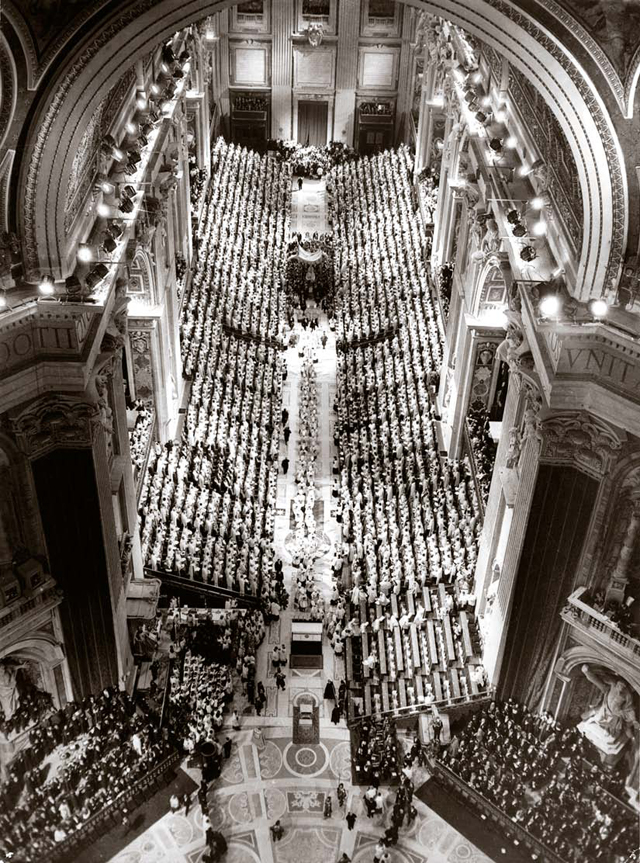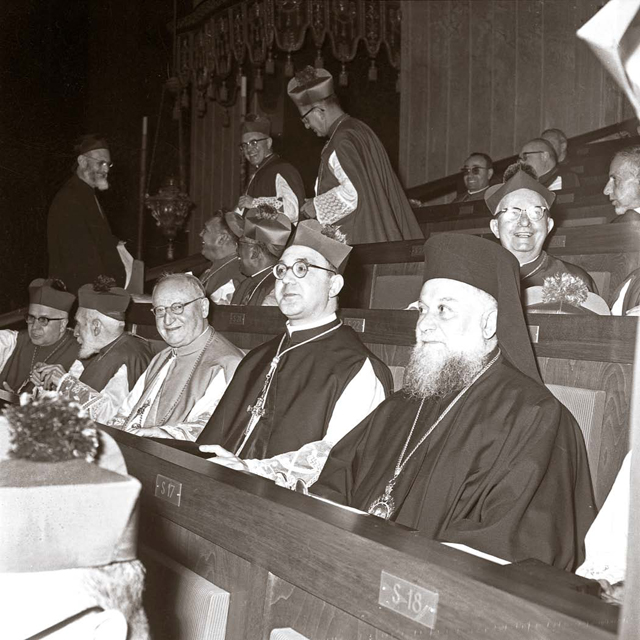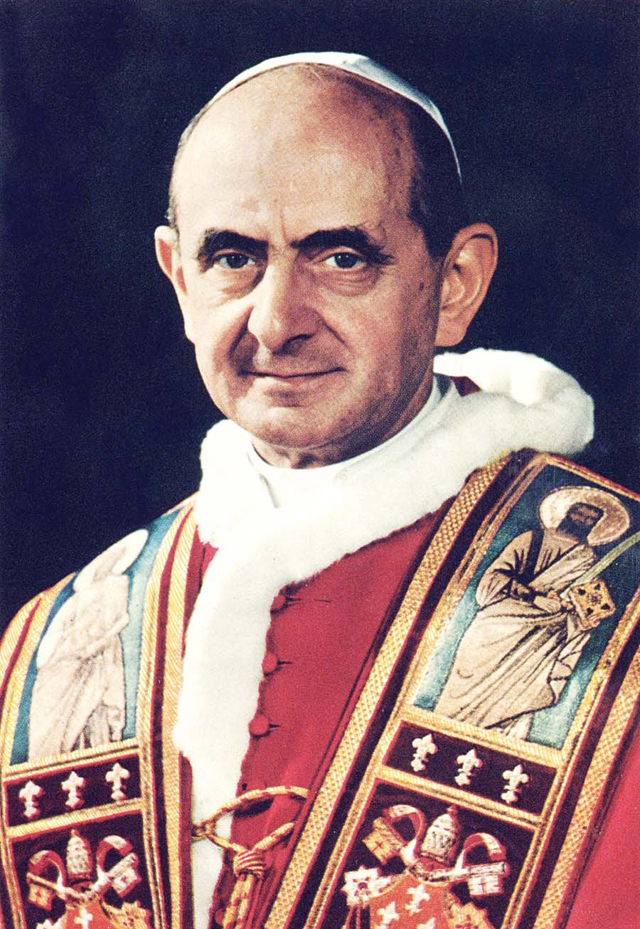Vatican II
Fact sheet
January/February 2012
Return to Table of Contents
Print Article
The Second Vatican Council opened on October 11, 1962. Pope John XXIII sought to define the nature, scope, and mission of the Church along with more than 2,000 bishops from all over the world.
 (Credit: Photo Service – L’Osservatore Romano)
(Credit: Photo Service – L’Osservatore Romano)The opening session of Vatican II. All sessions were held in the central nave of St. Peter’s Basilica (2,500 square metres). Rome.
By the time the Council closed on December 8, 1965, four key documents were drawn up:
- The Constitution of the Sacred Liturgy (Sacrosanctum Concilium)
- The Dogmatic Constitution of the Church (Lumen Gentium)
- The Constitution of Divine Revelation (Dei Verbum)
- The Pastoral Constitution on the Church in the Modern World (Gaudium et Spes)
As with papal encyclicals (letters), the first few words of the documents are taken as the title and indicate the key message of the text. The Latin titles of the four main documents are:
-
Sacrosanctum Concilium = Sacred Council
Lumen Gentium = Light of the Nations
Dei Verbum = The Word of God
Gaudium et Spes = Joys and Hopes
These constitutions form the heart of the Council’s teachings on the mystery of the Church. Twelve other documents expanded on the teaching of the central four:
- Decree on Priestly Training (Optatam Totius)
- Declaration on Christian Education (Gravissimum Educationis)
- Decree on Means of Social Communication (Inter Mirifica)
- Decree on Mission Activity of the Church (Ad Gentes)
- Declaration on the Relation to Non-Christian Religions (Nostra Aetate)
- Decree on Ecumenism (Unitatis Redintegratio)
- Decree on the Churches of the Eastern Rite (Orientalium Ecclesiarum)
- Declaration on Religious Freedom (Dignitatis Humanae)
- Decree on the Pastoral Office of Bishops (Christus Dominus)
- Decree on Ministry of Priests (Presbyterorum Ordinis)
- Decree on Apostolate of Laity (Apostolicam Actuositatem)
- Decree on Renewal of Religious Life (Perfectae Caritatis)
The largest number of bishops in recorded church history attended one or more of Vatican II’s sessions: a total of 2,860 bishops from all over the world. (Vatican I had 737 bishops.) Depending on the session, the number of bishops was between 2,000 and 2,500. Several communist countries refused to allow bishops to attend, and some bishops living under repressive regimes were afraid that if they left their countries they would not be allowed back in. As a result, at least 274 bishops could not take part in the council.
Present at the Council were:
-
1,089 bishops from Europe
489 bishops from South America
404 from North America
374 from Asia
296 from Africa
84 from Central America
75 from Oceania
Observer (non-voting status)
63 Protestant, Orthodox and Jewish religious leaders
52 lay women and men
Vatican II marked the first time that a large number of non-Catholics were invited to attend as guests and observers. And it was also the first time that women—lay and religious—were invited into the council hall, also as observers.
Many bishops brought along an aide, a translator (sessions were conducted in Latin) and a personal peritus, or expert. As the bishops waded deeper into new theological and pastoral territory in successive sessions, the number of their advisors and experts increased as well. While numbering about 200 in the first session, periti more than doubled, to 484, by the council’s end.
 (Credit: Photo Service – L’Osservatore Romano)
(Credit: Photo Service – L’Osservatore Romano)Procession to the Basilica at the opening of the Second Vatican Council. October 11, 1962, Rome.
Main themes of Vatican II
- The church as mystery, or sacrament — In the words of the late Pope Paul VI, this means that the Church is “imbued with the hidden presence of God.” The Church is called to be a visible, communal sign of the invisible, renewing presence of God in the world and in human history.
- The people of God — The Church is first and foremost people. It is also an institution. But it is primarily a community. The church is us— all the baptized.
- The church as servant — The mission of the Church includes service to human needs in the social, economic, and political orders, as well as the preaching of the word and the celebration of the sacraments.
- The church as communion — a communion between God and ourselves (the vertical dimension) and a communion of ourselves with one another in Christ by the power of the Holy Spirit (the horizontal dimension). The Church is collegial.
- The church is ecumenical — that is, embracing “the whole wide world” of Christians.
Glossary of terms
Aggiornamento: Italian for “updating”; used by Pope John XXIII to describe the church’s need to renew and update itself through the Second Vatican Council.
Ecumenical: Literally “universal,” from the Greek oikoumene, the inhabited world. Used to identify the church’s general councils which gathers bishops from all over the world. In the movement for Christian unity, the noun ecumenism has become synonymous with striving for unity among the Christian churches.
Peritus (plural Periti): Latin for “expert.” During the Second Vatican Council many bishops brought along their own experts in various disciplines, such as scripture, canon law or theology, to help their understanding of a topic and decision making.
Collegiality: An increased sense of shared authority, or collegiality, among bishops and between them and the pope, was underscored by the Second Vatican Council. Though admittedly a sensitive issue, some level of collegiality is seen in the world synods that have been regularly convoked in Rome since the Council. (Leonard Foley, OFM, Catholic Update) During the Council it became clear that the bishops of the world wanted to take more responsibility for the world-wide church and to act more collegially through National Bishops Conferences.
How councils evolved
The Second Vatican Council was the 21st council in church history and was so named because it was the second council to be held at the Vatican. The Acts of the Apostles records the church’s first official council: the council of Jerusalem in 51 AD. There the early church, under Peter’s leadership (following his own personal “conversion” experience), decided that converts to the new Christian faith were not to be obliged to make their entry through Judaism. The council ruled that new Christians did not need to follow Jewish practices such as circumcision and dietary laws. Here we have the first written record of church collegiality as the apostles conveyed their decision to the believers in Antioch: “It has seemed good to the Holy Spirit, and to us...” (Acts 15:28)
By the second century, church documents show that bishops from Africa to Greece were regularly getting together to decide matters of church teaching and pastoral practice in regional meetings, synods and councils. Until the strong centralization of the papacy at the end of the first millennium, many of these regional councils were called at the bishops’ own initiative; in some cases the pope was not even notified, or learned of their respective deliberations when the news finally made its way to Rome, sometime after several years.
...The first eight ecumenical councils were held in the East (starting in 325 AD): two in Nicaea, four in Constantinople, and one each in Ephesus and Chalcedon. The remaining 13 were held in the West: Lateran Councils I through V at the Basilica of Saint John Lateran in Rome, Vatican I and II at the Vatican, and one Council in Florence. Trent became a second home to many bishops (and their successors), running in 25 sessions over 18 years (Trent was interrupted by wars, internal politics, unrest among the faithful, and even the plague.) Two councils were held in Lyons, France.
www.natcath.org/NCR_Online/archives/100402/vaticanII.htm
Return to Table of Contents
Print Article


